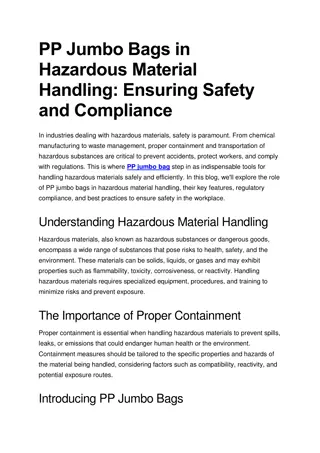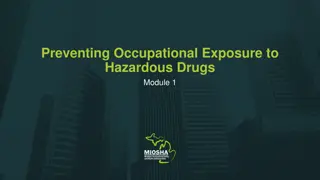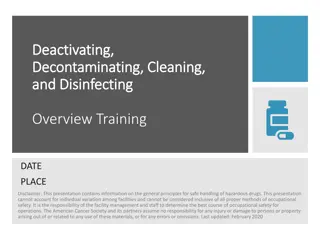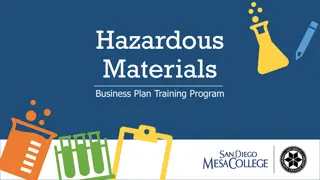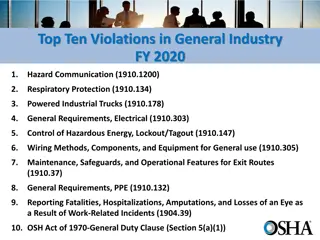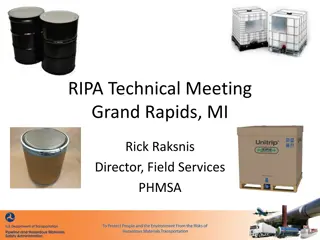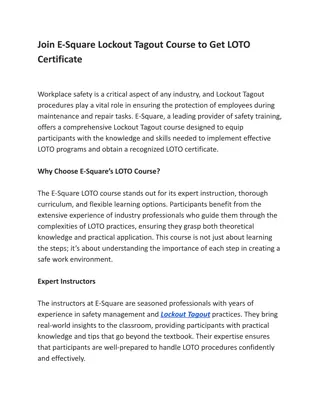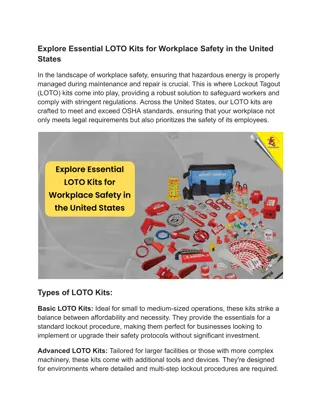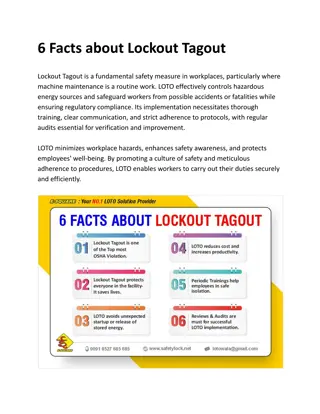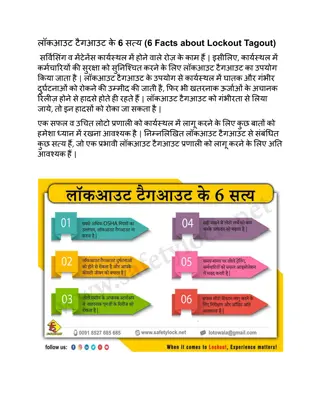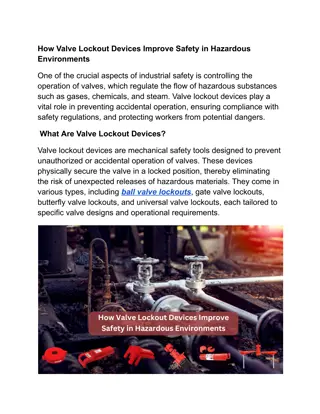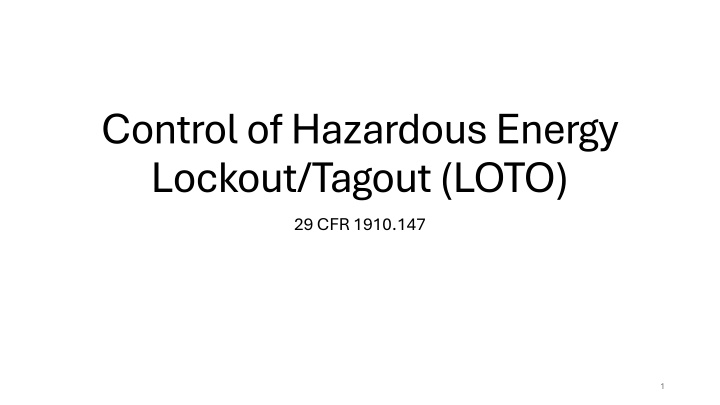
Control of Hazardous Energy: Lockout/Tagout Procedures
The purpose of Lockout/Tagout (LOTO) is to prevent serious injury or death from unexpected release of stored energy during servicing and maintenance of machines. LOTO establishes procedures to physically isolate stored energy sources like electrical, mechanical, hydraulic, pneumatic, and more. This standard applies when unexpected start-up or release of energy could occur during equipment maintenance. Exceptions exist for minor servicing activities during normal production operations. Detailed guidelines and examples are provided in the context of 29 CFR 1910.147.
Download Presentation

Please find below an Image/Link to download the presentation.
The content on the website is provided AS IS for your information and personal use only. It may not be sold, licensed, or shared on other websites without obtaining consent from the author. If you encounter any issues during the download, it is possible that the publisher has removed the file from their server.
You are allowed to download the files provided on this website for personal or commercial use, subject to the condition that they are used lawfully. All files are the property of their respective owners.
The content on the website is provided AS IS for your information and personal use only. It may not be sold, licensed, or shared on other websites without obtaining consent from the author.
E N D
Presentation Transcript
Control of Hazardous Energy Lockout/Tagout(LOTO) 29 CFR 1910.147 1
LOTO Purpose To prevent serious injury or death from the unexpected release of stored energy during servicing and maintenance of machines To establish procedures to physically isolate stored energy from the equipment being serviced or repaired Speaker Notes: Examples: 1) a guard needs to be removed to do the work; 2) a steam valve is automatically turned on burning workers who are repairing a downstream connection in the piping; 3) a jammed conveyor system suddenly releases, crushing a worker who is trying to clear the jam; 4) internal wiring on a piece of factory equipment electrically shorts, shocking worker who is repairing the equipment. [https://www.osha.gov/SLTC/controlhazardousenergy/index.html] 2
Types of Stored Energy Needing Isolation Electrical Mechanical Hydraulic Pneumatic Chemicals Thermal Other energy sources Speaker Notes: OSHA Lockout/Tagout Fact Sheet: https://www.osha.gov/OshDoc/data_General_Facts/factsheet-lockout-tagout.pdf 1910.147(b) Definitions applicable to this section. Energy source. Any source of electrical, mechanical, hydraulic, pneumatic, chemical, thermal, or other energy. 3
Speaker Notes: https://www.cdc.gov/niosh/docs/wp-solutions/2011-156/pdfs/2011-156.pdf 1910.147(a)(2) Application. 1910.147(a)(2)(i) This standard applies to the control of energy during servicing and/or maintenance of machines and equipment. LOTO Applies When servicing and maintaining equipment, and unexpected startup of the machine or released of stored energy could occur When, during normal production, workers must remove or bypass a guard or safety device When, during normal production, workers place and part of their body into the danger zone or near the machine s point of operation During all set up activities 4
Speaker Notes: 1910.147(a)(2)(ii) Normal production operations are not covered by this standard (See Subpart O of this Part). Servicing and/or maintenance which takes place during normal production operations is covered by this standard only if: 1910.147(a)(2)(ii)(A) An employee is required to remove or bypass a guard or other safety device; or 1910.147(a)(2)(ii)(B) An employee is required to place any part of his or her body into an area on a machine or piece of equipment where work is actually performed upon the material being processed (point of operation) or where an associated danger zone exists during a machine operating cycle. Note: Exception to paragraph (a)(2)(ii): Minor tool changes and adjustments, and other minor servicing activities, which take place during normal production operations, are not covered by this standard if they are routine, repetitive, and integral to the use of the equipment for production, provided that the work is performed using alternative measures which provide effective protection (See Subpart O of this Part). LOTO Exemption Normal Production Operations Routine, repetitive, & integral to production Guards/safety devices not bypassed Body part not placed in the point of operation or other dangerous area during machine cycle Need to use alternative measures for protection 5
LOTO Exemption Cord & Plug Connected Equipment Plug is only source of energy Plug is under continuous control of one person Cord is unplugged from energy source Speaker Notes: 1910.147(a)(2)(iii) This standard does not apply to the following: 1910.147(a)(2)(iii)(A) Work on cord and plug connected electric equipment for which exposure to the hazards of unexpected energization or start up of the equipment is controlled by the unplugging of the equipment from the energy source and by the plug being under the exclusive control of the employee performing the servicing or maintenance. 6
Speaker Notes: https://blogs.cdc.gov/niosh- science-blog/2014/07/07/loto/ Important LOTO Elements Written procedures Documentation of each source of energy Locking and tagging devices Verification of energy isolation Proper locks at proper places (isolation points) Training (including skills demonstration) in the primary language(s) of employees. Auditing of work process 7
Speaker Notes: 1910.147(b) Definitions applicable to this section. Authorized employee. A person who locks out or tags out machines or equipment in order to perform servicing or maintenance on that machine or equipment. An affected employee becomes an authorized employee when that employee's duties include performing servicing or maintenance covered under this section. Affected employee. An employee whose job requires him/her to operate or use a machine or equipment on which servicing or maintenance is being performed under lockout or tagout, or whose job requires him/her to work in an area in which such servicing or maintenance is being performed. Worker Categories Authorized employee Person who does LOTO to perform servicing Affected employee Person required to use machines/equipment on which servicing is performed under LOTO or who must work in such an area Other employees All employees who are or may be in an area were LOTO may be utilized 8
Speaker Notes: https://www.osha.gov/pls/oshaweb/owadisp.show_document?p_table=STANDARDS&p_id=9805 Sequence of Lockout (1) Notify all affected employees that servicing or maintenance is required on a machine or equipment and that the machine or equipment must be shut down and locked out to perform the servicing or maintenance. ________________________ Name(s)/Job Title(s) of affected employees and how to notify. (2) The authorized employee shall refer to the company procedure to identify the type and magnitude of the energy that the machine or equipment utilizes, shall understand the hazards of the energy, and shall know the methods to control the energy. ________________________ Type(s) and magnitude(s) of energy, its hazards and the methods to control the energy. (3) If the machine or equipment is operating, shut it down by the normal stopping procedure (depress the stop button, open switch, close valve, etc.). ________________________ Type(s) and location(s) of machine or equipment operating controls. (4) De-activate the energy isolating device(s) so that the machine or equipment is isolated from the energy source(s). ________________________ Type(s) and location(s) of energy isolating devices. (5) Lock out the energy isolating device(s) with assigned individual lock(s). (6) Stored or residual energy (such as that in capacitors, springs, elevated machine members, rotating flywheels, hydraulic systems, and air, gas, steam, or water pressure, etc.) must be dissipated or restrained by methods such as grounding, repositioning, blocking, bleeding down, etc. ________________________ LOTO Steps Shutdown Type(s) of stored energy - methods to dissipate or restrain. (7) Ensure that the equipment is disconnected from the energy source(s) by first checking that no personnel are exposed, then verify the isolation of the equipment by operating the push button or other normal operating control(s) or by testing to make certain the equipment will not operate. Caution: Return operating control(s) to neutral or "off" position after verifying the isolation of the equipment. ________________________ Method of verifying the isolation of the equipment. (8) The machine or equipment is now locked out. 1. Notify affected employees 2. Prepare for LOTO: review LOTO procedures, identify energy sources, confirm LOTO methods to be used and obtain necessary LOTO equipment 3. Shutdown machine following normal procedures 4. De-activate energy isolating devices 9
LOTO Steps Shutdown cont. 5. Lock out the energy isolating device(s) 6. Dissipate or restrain stored or residual energy 7. Verify machine is disconnected from the energy source(s) Speaker Notes: https://www.osha.gov/pls/oshaweb/owadis p.show_document?p_table=STANDARDS&p _id=9805 10
Speaker Notes: https://www.osha.gov/pls/oshaweb/owadisp.show_document?p_table=STANDARDS&p_id=9805 Restoring Equipment to Service. When the servicing or maintenance is completed and the machine or equipment is ready to return to normal operating condition, the following steps shall be taken. (1) Check the machine or equipment and the immediate area around the machine to ensure that nonessential items have been removed and that the machine or equipment components are operationally intact. (2) Check the work area to ensure that all employees have been safely positioned or removed from the area. (3) Verify that the controls are in neutral. (4) Remove the lockout devices and reenergize the machine or equipment. Note: The removal of some forms of blocking may require reenergization of of the machine before safe removal. (5) Notify affected employees that the servicing or maintenance is completed and the machine or equipment is ready for use. LOTO Steps Startup 1. Inspect machine and surrounding area to ensure machine ready for normal operation 2. Ensure affected employees are away from hazards 3. Remove locks and tags from isolation devices and reenergize machine 4. Notify affected employees of restart and verify machine is working properly 11
Energy Isolating Devices Speaker notes: 1910.147(b) Definitions applicable to this section. Energy isolating device. A mechanical device that physically prevents the transmission or release of energy, including but not limited to the following: A manually operated electrical circuit breaker; a disconnect switch; a manually operated switch by which the conductors of a circuit can be disconnected from all ungrounded supply conductors, and, in addition, no pole can be operated independently; a line valve; a block; and any similar device used to block or isolate energy. Push buttons, selector switches and other control circuit type devices are not energy isolating devices. Device that physically prevents the transmission or release of energy Includes: electrical circuit breakers, disconnect switches, line valves and a blocks Excludes: push buttons and selector switches 12
Speaker Notes: 1910.147(b) Definitions applicable to this section. Lockout device. A device that utilizes a positive means such as a lock, either key or combination type, to hold an energy isolating device in the safe position and prevent the energizing of a machine or equipment. Included are blank flanges and bolted slip blinds. Tagout device. A prominent warning device, such as a tag and a means of attachment, which can be securely fastened to an energy isolating device in accordance with an established procedure, to indicate that the energy isolating device and the equipment being controlled may not be operated until the tagout device is removed. 1910.147(c)(5) Protective materials and hardware. 1910.147(c)(5)(i) Locks, tags, chains, wedges, key blocks, adapter pins, self-locking fasteners, or other hardware shall be provided by the employer for isolating, securing or blocking of machines or equipment from energy sources. 1910.147(c)(5)(ii) Lockout devices and tagout devices shall be singularly identified; shall be the only devices(s) used for controlling energy; shall not be used for other purposes; and shall meet the following requirements: 1910.147(c)(5)(ii)(A) Durable. 1910.147(c)(5)(ii)(A)(1)Lockout and tagout devices shall be capable of withstanding the environment to which they are exposed for the maximum period of time that exposure is expected. 1910.147(c)(5)(ii)(A)(2)Tagout devices shall be constructed and printed so that exposure to weather conditions or wet and damp locations will not cause the tag to deteriorate or the message on the tag to become illegible. 1910.147(c)(5)(ii)(A)(3)Tags shall not deteriorate when used in corrosive environments such as areas where acid and alkali chemicals are handled and stored. 1910.147(c)(5)(ii)(B) Standardized. Lockout and tagout devices shall be standardized within the facility in at least one of the following criteria: Color; shape; or size; and additionally, in the case of tagout devices, print and format shall be standardized. 1910.147(c)(5)(ii)(C) Substantial - 1910.147(c)(5)(ii)(C)(1)Lockout devices. Lockout devices shall be substantial enough to prevent removal without the use of excessive force or unusual techniques, such as with the use of bolt cutters or other metal cutting tools. 1910.147(c)(5)(ii)(C)(2)Tagout devices. Tagout devices, including their means of attachment, shall be substantial enough to prevent inadvertent or accidental removal. Tagout device attachment means shall be of a non-reusable type, attachable by hand, self-locking, and non-releasable with a minimum unlocking strength of no less than 50 pounds and having the general design and basic characteristics of being at least equivalent to a one-piece, all environment-tolerant nylon cable tie. 1910.147(c)(5)(ii)(D)Identifiable. Lockout devices and tagout devices shall indicate the identity of the employee applying the device(s). 1910.147(c)(5)(iii)Tagout devices shall warn against hazardous conditions if the machine or equipment is energized and shall include a legend such as the following: Do Not Start. Do Not Open. Do Not Close. Do Not Energize. Do Not Operate. LOTO Devices Includes locks, tags, chains, wedges, key blocks, and self-locking fasteners Uniquely identified and used only for controlling energy Durable Standardized Substantial Identify employee applying device Tags must have special warnings 13
Speaker Notes: 1910.147(c)(7)Training and communication. 1910.147(c)(7)(i)The employer shall provide training to ensure that the purpose and function of the energy control program are understood by employees and that the knowledge and skills required for the safe application, usage, and removal of the energy controls are acquired by employees. The training shall include the following: 1910.147(c)(7)(i)(A)Each authorized employee shall receive training in the recognition of applicable hazardous energy sources, the type and magnitude of the energy available in the workplace, and the methods and means necessary for energy isolation and control. 1910.147(c)(7)(i)(B)Each affected employee shall be instructed in the purpose and use of the energy control procedure. 1910.147(c)(7)(i)(C)All other employees whose work operations are or may be in an area where energy control procedures may be utilized, shall be instructed about the procedure, and about the prohibition relating to attempts to restart or reenergize machines or equipment which are locked out or tagged out. 1910.147(c)(7)(ii)When tagout systems are used, employees shall also be trained in the following limitations of tags: 1910.147(c)(7)(ii)(A)Tags are essentially warning devices affixed to energy isolating devices, and do not provide the physical restraint on those devices that is provided by a lock. 1910.147(c)(7)(ii)(B)When a tag is attached to an energy isolating means, it is not to be removed without authorization of the authorized person responsible for it, and it is never to be bypassed, ignored, or otherwise defeated. 1910.147(c)(7)(ii)(C)Tags must be legible and understandable by all authorized employees, affected employees, and all other employees whose work operations are or may be in the area, in order to be effective. 1910.147(c)(7)(ii)(D)Tags and their means of attachment must be made of materials which will withstand the environmental conditions encountered in the workplace. 1910.147(c)(7)(ii)(E)Tags may evoke a false sense of security, and their meaning needs to be understood as part of the overall energy control program. 1910.147(c)(7)(ii)(F)Tags must be securely attached to energy isolating devices so that they cannot be inadvertently or accidentally detached during use. 1910.147(c)(7)(iv)The employer shall certify that employee training has been accomplished and is being kept up to date. The certification shall contain each employee's name and dates of training. Training All employees must be trained based on worker categories Must ensure employees understand LOTO program Must address limitations of tags if they are used as part of LOTO 14
Speaker Notes: 1910.147(c)(7)Training and communication. 1910.147(c)(7)(iii)Employee retraining. 1910.147(c)(7)(iii)(A)Retraining shall be provided for all authorized and affected employees whenever there is a change in their job assignments, a change in machines, equipment or processes that present a new hazard, or when there is a change in the energy control procedures. 1910.147(c)(7)(iii)(B)Additional retraining shall also be conducted whenever a periodic inspection under paragraph (c)(6) of this section reveals, or whenever the employer has reason to believe that there are deviations from or inadequacies in the employee's knowledge or use of the energy control procedures. 1910.147(c)(7)(iii)(C)The retraining shall reestablish employee proficiency and introduce new or revised control methods and procedures, as necessary. Retraining Authorized/Affected Employees: when change in job, change in machines and change in LOTO program When evidence indicates employees lack knowledge of LOTO program 15


